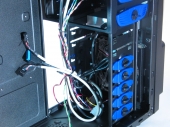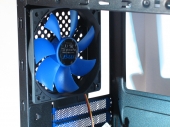
Internal Design
As with all mid-tower cases, getting a system installed requires careful planning. The limited room to maneuver, especially around the sides and top of the motherboard, may tempt you to leave off installing the CPU cooler until after the motherboard is mounted. If you’re planning on using the stock Intel cooler, this may work out okay for you. If your cooler requires a backplate to mount securely though, you’ll probably want to go ahead and put it in before you mount the motherboard. The tray cutout is not properly positioned for modern Intel boards, and therefore won’t be much help.
 |
The tool-less retention systems in this case are a bit of a mixed bag. The expansion slot bracket functions by the simple expedient of pushing down on the top of the brackets with an aluminum plate. It holds things in place fairly well, though you’ll need to carefully re-position all your cards whenever you loosen it. The drive retention clips are rather less robust; they had a tendency to pop loose while I was trying to put them in place.
 |
The case is made entirely of steel, but you’d hardly know it by the weight. The panels are all fairly thin and light, which is common on PC cases today. Unfortunately this lightness, combined with the stiff plastic retention clips, causes hard drive activity to vibrate the whole case. They provide enough screws in the accessory kit to secure the drives the normal way instead, and I would recommend this route; screwing down the drives to the frame lessened the vibration noise a fair bit. Also, due to the close confines, you should leave gaps between hard drives, otherwise airflow may be negatively impacted.
 |
The front and side fans are quiet, but don’t move much air. You may want to consider replacing these fans with higher rpm/CFM fans to handle an increased thermal load if you plan to have an SLI/Crossfire setup. Luckily, changing them out is a simple task. The side panel also allows for replacing the 200mm fan with a pair of 120s. Because of all the mesh panels on the case, static pressure inside is quite low; you’ll want to stick a strong 120mm near the video card if you have any heat issues. Conversely, because there is so much ventilation, mid-range components should need no additional help to stay within normal temperature ranges.
 |

[…] 550D Case @ VortezCubitek HPTX ICE Case @ TweaktownMSI Nighthawk Case @ TechwareLabsNZXT Phantom 410 Case @ BCCHardwareNZXT Phantom 410 Case @ Hi Tech LegionThermaltake Chaser MK-1 […]
[…] Corsair 550D Case @ Vortez Cubitek HPTX ICE Case @ Tweaktown MSI Nighthawk Case @ TechwareLabs NZXT Phantom 410 Case @ BCCHardware NZXT Phantom 410 Case @ Hi Tech Legion Thermaltake Chaser […]
[…] MSI Nighthawk Case/Chassis Review @ TechwareLabs […]